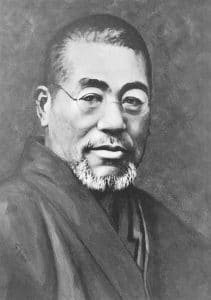
This particular meditation is said by some to have been practised by Usui Mikao while meditating on kurama yama or hiei zan.
Zazen Shikan Taza
A) Outside the meditation hall or spiritual practice area
1. Shikan Zen Yo No Ichi Ge (The Verse Displaying the Main Point of Samatha-Vipasyana Meditation)
Recite once:
In the genuine practice of entering Nirvana, apparently there are a multitude of roads. But if we think about only the most vital necessities, two methods stand out. The first, Samatha, quiets one’s evil passions, and the second, Vipasyana, further leads one to deny unwholesome desires. When Samatha (stopping) results in one’s winning entry into Dhyana-Samadhi (meditation trance), then Vipasyana (insight) becomes the foundation of Prajna (wisdom). When both Samatha and Vipasyana are successfully practiced, the meditator enters Samadhi and receives Prajna. In that state, the Dharmaís altruistic goal of helping both self and others is fully completed.
2. Kokoro No Ryo (Verse on Food for the Heart/Mind)
Recite once each:
Practicing the Dharma includes food and clothes, but in food and clothes the practice of Dharma is not found.
Monetary wealth is not a national treasure; a person who brightens a single corner is a national treasure.
The height of compassion is to welcome evil onto myself while giving good deeds to other people, and to forget myself while doing good for others.
By holding grudges and repaying with hatred, hatred never ends; but by repaying with virtue, hatred is completely exhausted. Rather than bearing grudges about the things happening in this long night’s dream called the world, cross the boundary into the Dharma realm of the true Buddha.
3. Method of Entering the Hall
Line up outside the Hall. Recite the Sange Mon (Repentance Verse) once:
Ga Shaku Sho Zo Sho Aku Go, Kai Yu Mu Shi Ton Jin Chi, Ju Shin Go I Shi Sho Sho , Issai Ga Kon Kai Sange
From beginningless time I have generated negative karma through my misdirected thoughts, words and deeds. I wish to acknowledge and atone for all.
Enter the hall.
B) Within the meditation hall or spiritual practice area
4. San Rai (Three Prostrations)
Recite three times, each time performing a Grand Prostration:
Isshin Chorai Jippo Hokai Joju Sanbo
5. Ten Non-Virtuous States of Mind (The Recitation on Self Discipline)
This is done individually. Contemplate:
Reflecting on my own life, I should abandon those heart-states in which bad actions accumulate, namely the realms of hells, animals, hungry ghosts, fighting entities, mundane life, heavens, evil spirits, hinayana followers, professional priests, and conflicting emotions.
6. Godai Gan (Five Great Vows)
Shujo Muhen Segan Do
Fukuchi Muhen Segan Shu
Homon Muhen Segan Gaku
Nyorai Muhen Segan Ji
Mujo Bodai Segan Jo
Goji Busshi Jodaigan
Sentient Beings are limitless, I vow to save them all.
Knowledge and wisdom are limitless, I vow to accumulate them all.
The Dharmas are infinite, I vow to study them all.
The Tathagatas are endless, I vow to serve them all.
Supreme Enlightenment is unsurpassed. I vow to attain it.
May this seeker of enlightenment fulfil these vows.
Take your seat for meditation.
7. Entering Samadhi
First, check one’s posture. If sitting in the half-lotus position, place the left leg over the right leg. Pull it close to the body, with the left toes and the right heel equally spaced. Loosen the belt and arrange the clothes neatly so as to cover the legs. Form the meditation mudra with the hands in the lap, right palm on top of the left palm, with the tips of the thumbs lightly touching, pulled close under the stomach. Twist the body left and right a number of times, coming to rest in a correct, straight posture. The backbone should not be curved, and the shoulders are thrown back. If the posture should relax, without hurrying, quickly correct it.
Clear the air passages, expelling muddy spirits. Exhale with the mouth open, releasing the stagnant air slowly while leaning slightly forward. Don’t exhale quickly or slowly, but continue until you are satisfied. Breathe all defects out during exhalation, completely exhausting them. The straighten up again, and through the nose breathe in endless, pure spirit. Imagine it entering through the top of the head, in and out three times.
Then with the torso straight and relaxed, allow the diaphragm to move in tandem with the movement of air through the nose. Close the mouth, teeth lightly together, tongue against the upper palate. With the eyes half-closed to reduce the brightness of the outside light, let the line of sight fall about six feet in front.
Second, check the breathing. Listening to the sound of the in- and out-breaths, it should not be loud, not gasping or sucking in air, not jerky, puckering or sliding. Allow the breathing to remain in a natural state, as if in a closed system.
Third, check the activity of the thoughts. Separate the attention from the breathing and concentrate it at the red field. Abandon those thoughts outside the practice, such as gross thoughts, random thoughts, day dreaming, thoughts about emotional ups and downs, or relaxed and uptight states.
8. Dwelling in Samadhi
Observe the harmony of the Three Mysteries of the body, the breath, and the thoughts. Note when the three are not in harmony, and continually apply mindfulness and recollection to again produce unity and harmony of the body, breath, and thoughts. Rely on this practice to cross over. One sits single-pointedly, not being shaken by thoughts or activities of daily life, not even if enveloped in raging flames.
9. Exiting Samadhi
First, release the mind from Samadhi, and establish connections and relations. Next, open the mouth and breathe deeply so as to release the spirit. Next, move the body very slightly. Then move the hands, arms, elbows, shoulders, neck and head. Next, rub the pores of the whole body, then rub the palms together, using the warmth to cover the eyes. Next, open the eyes behind the palms. Finally, light incense or recite sutras depending on the time.
10. Method for Leaving the Hall
If there is time, recite sutras. This can be the Heart Sutra, the Ten-Verse Kannon Sutra, portions of the Lotus Sutra, the Sutra of Saintly Fudo, or any other sutra you choose. You may also chant the Nembutsu and dedicate merit.
Finally, recite the San Rai (Three Prostrations) again, three times, each time performing a Grand Prostration.
Isshin Chorai Jippo Hokai Joju Sanbo
Depart the hall.
From the Mount Hiei Summer Ango
Translated by Keisho, compiled by Jiho
Edited from original by Jion Prosser
Tendai Lotus Teachings in co-operation with Mount Hiei, Japan
Tendai Lotus Teachings
© Tendai Lotus Teachings
Bronwen and Frans Stiene are the co-founders of the International House of Reiki and co-authors of The Reiki Sourcebook, The Japanese Art of Reiki, Your Reiki Treatment, The A-Z of Reiki Pocketbook and the Reiki Techniques Card Deck. Bronwen and Frans teach in the USA, Europe and Australia. Visit the Courses page to find a course near you.

